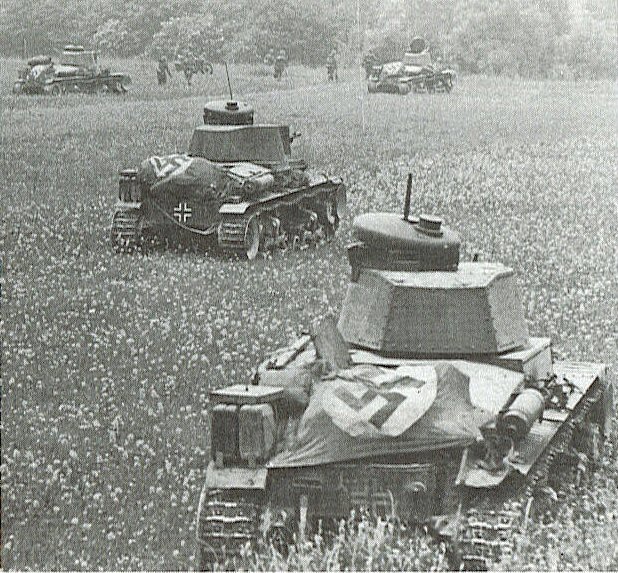The Kriegsausrüstungsnachweisung (KAN) was a detailed list prepared by the Wehrmacht command for every type of unit, showing the gear with which that unit was to be equipped. The KAN did not list items like mess kits and canteens, that were issued to soldiers, but rather unit-level assets like weapons and vehicles. Here are two pages from two different wartime KAN documents. The typewritten one is from a leichte Panzer-Aufklärungskompanie (gepanzert), and the printed one is from a Maschinengewehrkompanie eines Jägerbataillons und eines Radfahr-Maschinengewehrbataillons. Both of these documents list in the “General long-distance signalling equipment” section, a “Swastika flag 1.5 x 5 meters” (Hakenkreuzfahne 1.5 x 5 m).
Here are a couple of photos that appear to show this type of large recognition banner in use. The propaganda film “Sprung in den Feind” also shows one of these at the 21:41 minute mark.
Here is a surviving original aerial recognition flag in this regulation 1.5 x 5 m size. Aerial recognition flags were single-sided, and had grommets for lashing them to objects on the ground. This banner has grommets at the corners and also at the center of each long side. Some of the photos include a German helmet, for scale.
Wehrmacht aerial recognition flags were also produced in smaller sizes.

Here are two originals. The larger measures 1 x 2 m. This is a common size of original aerial recognition flag to find today. The smaller one measures about 80 x 90 cm. Note that on the small flag, both the red field and the white roundel have seams, showing they were made of separate pieces of fabric that were pieced together. This was necessary due to the shortage of raw material for war production.
Some wartime aerial recognition banners used the “Balkenkreuz” military emblem rather than the Nazi swastika. The wartime photo shown here is the only one known to this writer, depicting this flag in wartime German use. The original shown here measures 1 x 2 m.
Aerial recognition drapes can be distinguished from other German 1935-45 national flags by the presence of the grommets and the single-sided construction. For comparison purposes, here is a very long national banner that would have hung from a pole or building. It’s double sided. The bottom end has a small, leather reinforced, web strap with snap hook for anchoring it, while the top end is sleeved for a pole. The pole sleeve on this one was torn by the American soldier who ripped this from its mounting when he took it as a souvenir.














